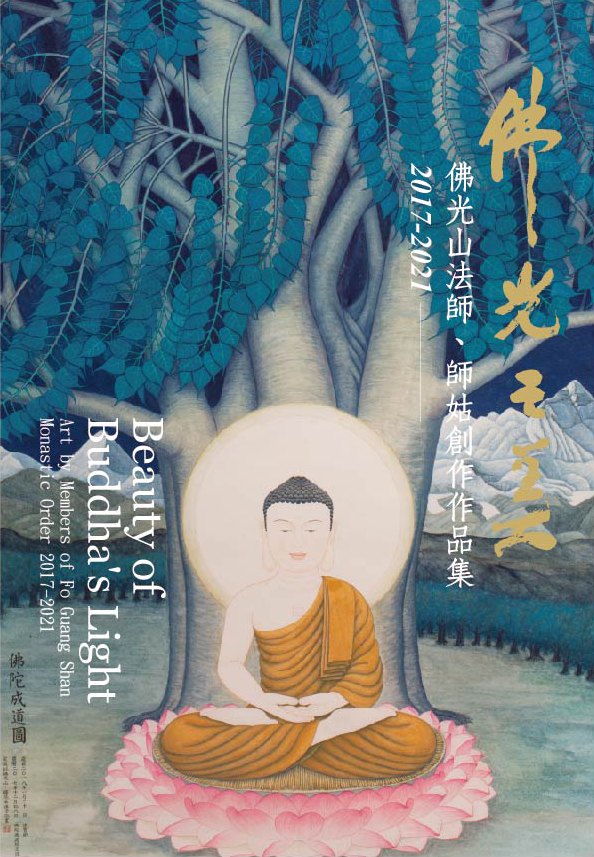《佛光之美》 心保和尚︱佛光山住持

在中國傳統文化中,很多都與佛教有甚深的關聯,如語言、飲食,乃至書畫藝術等,甚至許多僧人也是書畫名家,從唐朝懷素、貫休,至清初更有四僧名家:弘仁(江韜)、髡殘(石谿)、八大山人(朱耷)、原濟(石濤),乃至近代弘一等等,這些歷代高僧作品至今仍為世人所景仰。
所謂「道藝一體」,僧人的修行與書藝並不相違,甚至文化藝術更有助於佛教之弘化!最具代表者當屬家師——星雲大師。「星雲大師一筆字書法展」至今在全球超過25個國家展出逾170場次,因此而接觸了佛教、信仰了佛教,乃至因為佛法而得到喜悅的人,實在難以計數。
星雲大師相當重視文化,甚至表示如果寺廟裡連一張勸人向善的字畫都沒有,這寺廟沒有文化。大師以敦煌石窟的概念蓋了佛光山的殿堂,佛光山很多的建築物,室內牆壁也都掛了字畫。受師父的影響,弟子們所負責的道場也是如此。
大師不僅自己寫書法,也鼓勵徒眾發揮所長從事創作,還為此每年舉辦「佛光山徒眾作品聯展」,我想這不僅是佛教界的創舉,對於佛法的生活化更有著潛移默化之功。「以文化弘揚佛法」是大師大化於無形的般若智慧,也是人間佛教的具體實踐。
今年在佛光緣美術館總館長如常法師的用心規劃下,不僅將徒眾作品舉辦全球巡迴展,同時將前五年優選以上作品集結出版《佛光之美─佛光山法師、師姑創作作品集》,為當今人間佛教留下文獻。感謝所有徒眾的集體創作,謹以此共勉是為序!
Beauty of Buddha's Light
Most Venerable Hsin Bau︱Abbot of Fo Guang Shan Monastery
In traditional Chinese culture, many of them are deeply related to Buddhism, such as language and diet to painting and calligraphy. Many monks are also famous painting and calligraphy artists. From the Monk Huai Su and Guan Xiu of the Tang Dynasty to the early Qing Dynasty, there were four famous monks: Hong Ren (Chiang Tao), Kun Chan (Shi Xi), Bada Shanren (Chu Da), Yuan Ji (Shi Tao). Venerable Hong Yi is an example of the modern times. The works of these eminent monks from past dynasties have retained timeless admirations from people around the world.
The so-called "Unification of Bodhi and Arts" resonates the suggestion that the practice of monks do not depart from calligraphy. Culture and art are in effect very helpful in the propagation of Buddhism! The most notable representation of this concept is certainly our Master, Venerable Master Hsing Yun. "Venerable Master Hsing Yun’s One-Stroke Calligraphy Exhibition" has been exhibited over 170 times in more than 25 countries around the world. As a result, it is difficult to count the number of people who became in touch with Buddhism, believe in Buddhism, and even gain Dharma joy because of Master Hsing Yun’s artistic works.
The Master deeply values culture, and if there is no calligraphy or painting in the temple to encourage people to be good, then the temple has no culture. The Master constructed Fo Guang Shan from the concept of Dunhuang Caves. Many buildings in Fo Guang Shan have calligraphy and paintings on the indoor walls. Under the influence of the Master, the disciples follow the same in their own branches respectively.
The Master not only writes calligraphy himself; he also encourages his disciples to use their talents creatively. For this reason, the "FGS Monastic Art Exhibition" has been held every year. I believe the art exhibitions have not only served as a pioneering undertaking in Buddhism; it also an imperceptible influence on the promotion of Humanistic Buddhism. "Promoting Buddhism through Culture" is a formless Prajna wisdom of the Master’s fundamental instrument in putting Humanistic Buddhism into the practice.
This year, under the curator of the Fo Guang Yuan Art Gallery and Venerable Ru Chang’s elaborate planning, the disciples’ works will hold a touring exhibition globally. At the same time, selected works from the past five years will be published in "The Beauty of Buddha’s Light: Art by the Members of Fo Guang Shan Monastic Order 2017-2021" as documentation of today’s Humanistic Buddhism. Thanks to all the disciples for their collective works, and continue to inspire each other as this preface!
